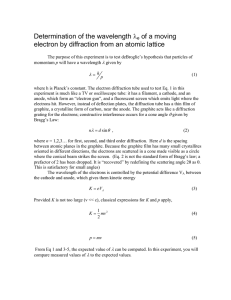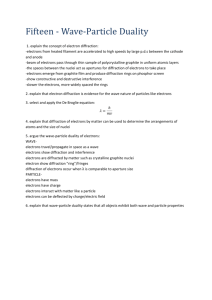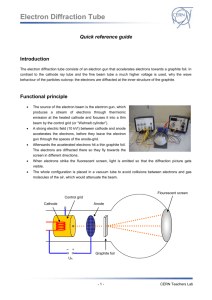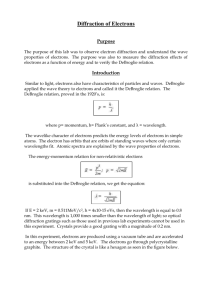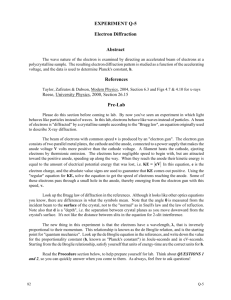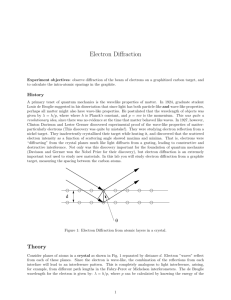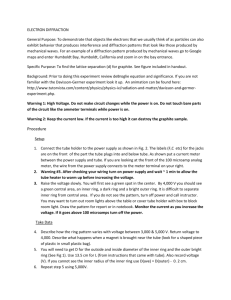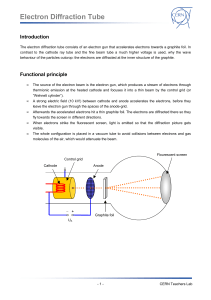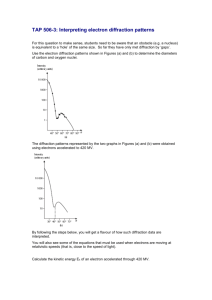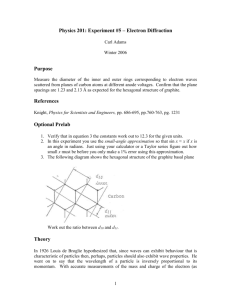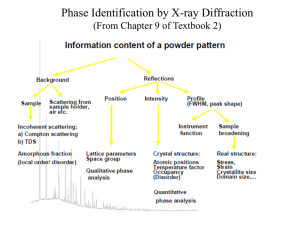TAP 506- 1: Diffraction of electrons
advertisement
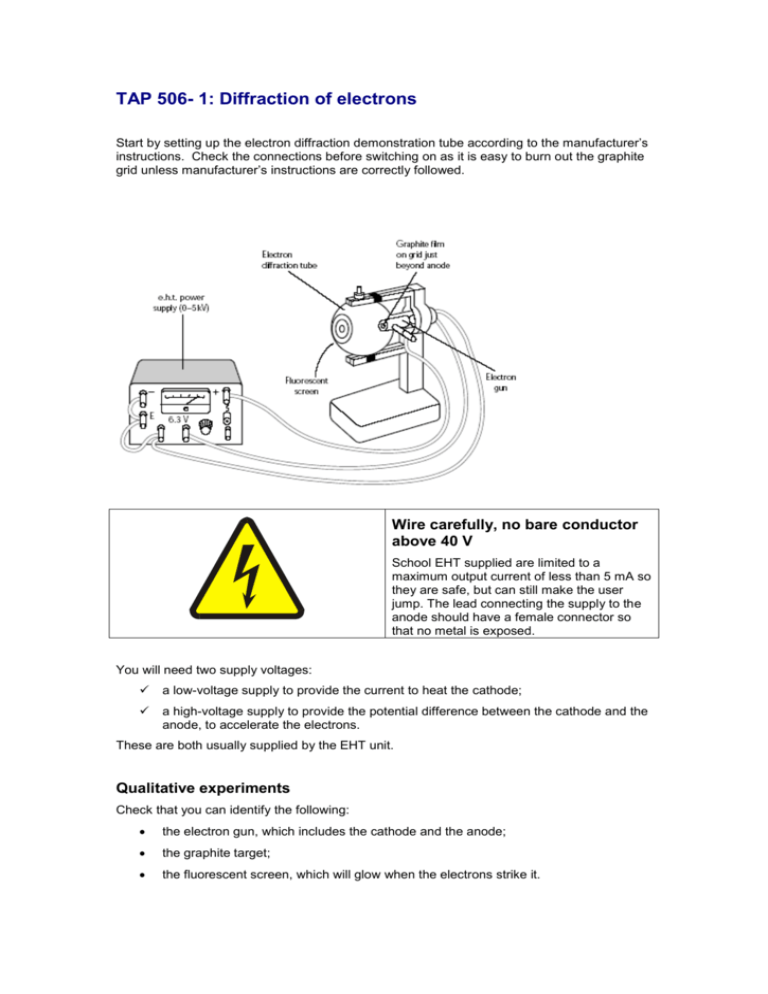
TAP 506- 1: Diffraction of electrons Start by setting up the electron diffraction demonstration tube according to the manufacturer’s instructions. Check the connections before switching on as it is easy to burn out the graphite grid unless manufacturer’s instructions are correctly followed. Wire carefully, no bare conductor above 40 V School EHT supplied are limited to a maximum output current of less than 5 mA so they are safe, but can still make the user jump. The lead connecting the supply to the anode should have a female connector so that no metal is exposed. You will need two supply voltages: a low-voltage supply to provide the current to heat the cathode; a high-voltage supply to provide the potential difference between the cathode and the anode, to accelerate the electrons. These are both usually supplied by the EHT unit. Qualitative experiments Check that you can identify the following: the electron gun, which includes the cathode and the anode; the graphite target; the fluorescent screen, which will glow when the electrons strike it. When the cathode has heated up (you will see it glowing), increase the accelerating voltage V. An invisible beam of electrons emerges from the electron gun and passes through the graphite film. To show that there is an electron beam present, bring up a bar magnet close to the tube and observe the pattern shifting. Magnetic fields deflect moving electrons. So this qualitative demo shows both the wave aspects (the diffraction pattern) and the particle aspects (deflection by a magnetic field) in the same equipment. Look for a diffraction pattern on the screen at the end of the tube. What shape is the pattern? Where can you see constructive interference? And destructive interference? Now predict: If you increase the accelerating voltage, how will the energy and speed of the electrons change? How will this affect the diffraction pattern? Test your ideas. Quantitative experiments Choose a feature of the diffraction pattern that is easy to measure. It might be the diameter of the first bright ring, or of the first dark ring. We will call this chosen quantity d. Investigate how d depends on V. Make several measurements. Determine the mathematical relationship between d and V. If the relationship is of the form d proportional to Vn, you can find the value of n by plotting a log-log graph. The gradient of the graph is equal to the value of n. What other information would you need if you were to use this experiment to determine the atomic spacing in graphite? Practical advice It is difficult to present a convincing discussion of wave–particle duality in a few lines. We have adopted the approach that it is an observed phenomenon, witness the diffraction of electrons. The de Broglie equation wavelength = h/p simply allows us to translate between the wave and particle pictures. Increasing the accelerating voltage increase the electrons’ energy and momentum; greater momentum means shorter wavelength, which in turn means that the electrons are diffracted through a smaller angle. Hence the diameters of the diffraction rings get smaller. Students could make measurements of the rings and relate these to the accelerating voltage. A log-l graph will reveal the relationship between them. It is reasonable to say that ring diameter is proportional to wavelength; a log-log graph of diameter against voltage will thus be a straight line with gradient (-1/2). Apparatus electron diffraction tube power supply (6.3 V) for cathode e.h.t. supply (0 – 5000 V dc) with voltmeter connecting leads Great care must be taken to set the tube up correctly. The graphite can be damaged by incorrect connections. Notice that the positive e.h.t supply terminal is used without the protective resistor in some set ups. Take care. As the discussion in this section is almost entirely in terms of electron diffraction, students might get the idea that only electrons exhibit wave–particle duality whereas in fact it applies to all particles. You might like to mention that neutron diffraction is also used as a tool for probing material structure. Large bio-molecules have now been diffracted. The chosen method is to introduce wave particle duality via the experiment however a little mathematics may be of use. This mathematics is given so an experimental or theoretical route can be chosen or the mathematics later used to back up the experiment. E=hf and since f c then E =hc/ Taking E = mc2 then mc2 = hc/and so mc = h/ momentum = mass x velocity = p =mc And this gives the de Broglie relation p = h/ Do notice that the switch from mc to mv has not been justified other than it works. (Note, this derivation really only refers to photons and not to electrons). For the diffraction tube where V is the anode cathode pd and v the electron speed then ½ mv2 = eV so v = (2eV/m) 1/2 giving mv = m (2eV/m) 1/2 = (2meV) 1/2 p = h/ = (2meV) 1/2 Tube screen Graphite Target d θ D Simplifying the Bragg formula into a two dimensional treatment for a transmission grating, for diffraction θ = /b (approximately) where b is the separation between the planes of carbon atoms. D, if required, can be obtained from manufacturers details. θ = d/D from geometry so d/D = /b or proportional to d as diffracting gap size b and target screen distance D are constants. So using the momentum and accelerating pd equation above then p = h/ = (2meV) 1/2 or 1/ is proportional to V1/2 or is proportional to V-1/2 External references This activity is taken from Salters Horners Advanced Physics, section PRO, activity 18, with extra material added in the last two sections, adapted from Revised Nuffield Advanced Science Physics teachers guide, book 2, section L2.
